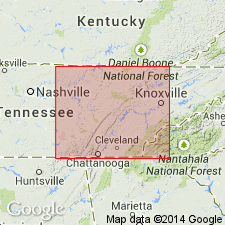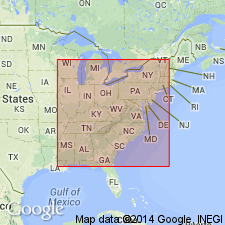
- Usage in publication:
-
- Petros sandstone
- Modifications:
-
- Original reference
- Dominant lithology:
-
- Sandstone
- Shale
- AAPG geologic province:
-
- Appalachian basin
Summary:
Pg. 6, 19, pls. 2, 3, 4. Petros sandstone of Slatestone group. Two sandstones (labeled Upper Petros and Lower Petros) separated by a shale break that includes Petros coal. Thickness 50 to 60 feet in type area; 45 feet in Cross Mountain section. Underlies a shale interval 40 to 170 feet thick that includes Blue Gem coal and in turn underlies Sand Gap sandstone (new); overlies a shale interval 40 to 190 feet thick that contains Coal Creek coal and in turn overlies the Stephens sandstone (new). Age is Early Pennsylvanian (Pottsville).
Named from town of Petros, Morgan Co., eastern TN.
Source: Publication; US geologic names lexicon (USGS Bull. 1200, p. 2999).

- Usage in publication:
-
- Petros Sandstone Member*
- Modifications:
-
- Overview
- AAPG geologic province:
-
- Appalachian basin
Summary:
Used as Petros Sandstone Member of Slatestone Formation. Commonly divided into lower and upper parts (termed by some workers as Lower and Upper Petros Sandstone Members), with Petros coal in between them.
Source: GNU records (USGS DDS-6; Reston GNULEX).
For more information, please contact Nancy Stamm, Geologic Names Committee Secretary.
Asterisk (*) indicates published by U.S. Geological Survey authors.
"No current usage" (†) implies that a name has been abandoned or has fallen into disuse. Former usage and, if known, replacement name given in parentheses ( ).
Slash (/) indicates name conflicts with nomenclatural guidelines (CSN, 1933; ACSN, 1961, 1970; NACSN, 1983, 2005, 2021). May be explained within brackets ([ ]).

